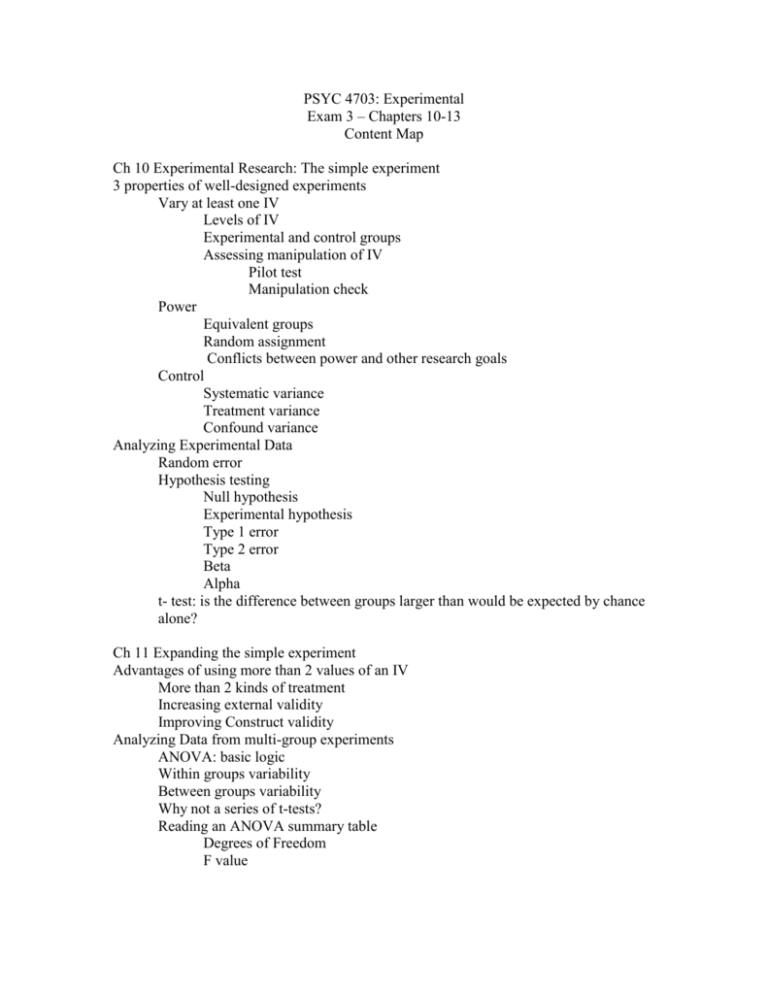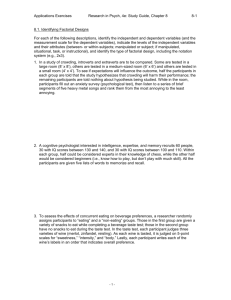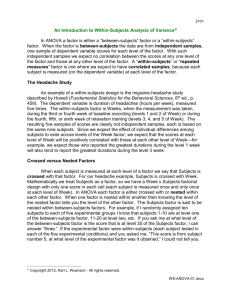Experimental
advertisement

PSYC 4703: Experimental Exam 3 – Chapters 10-13 Content Map Ch 10 Experimental Research: The simple experiment 3 properties of well-designed experiments Vary at least one IV Levels of IV Experimental and control groups Assessing manipulation of IV Pilot test Manipulation check Power Equivalent groups Random assignment Conflicts between power and other research goals Control Systematic variance Treatment variance Confound variance Analyzing Experimental Data Random error Hypothesis testing Null hypothesis Experimental hypothesis Type 1 error Type 2 error Beta Alpha t- test: is the difference between groups larger than would be expected by chance alone? Ch 11 Expanding the simple experiment Advantages of using more than 2 values of an IV More than 2 kinds of treatment Increasing external validity Improving Construct validity Analyzing Data from multi-group experiments ANOVA: basic logic Within groups variability Between groups variability Why not a series of t-tests? Reading an ANOVA summary table Degrees of Freedom F value Ch 12 Factorial Designs Benefits of factorial designs Information yielded by factorial design Simple main effects Overall main effects Interaction effects How to calculate different effects Interactions and moderating variables Potential results of a factorial experiment Analyzing results Degrees of freedom F value Interpreting main effects Interpreting interactions Hybrid designs – studying non-experimental factors Limitation Reasons to use Ch 13 Matched pairs design Procedure Considerations Effective matching variable Power & the dependent groups t-test External validity Construct validity Data analysis: dependent groups t-test Repeated measures designs Considerations Power Order effects Practice Fatigue Carry-over Sensitization Randomized within subjects design Procedure Analysis of data Counterbalanced within-subjects design Advantages and disadvantages Procedure Analysis Mixed design Choosing the right design (table 13-11) One IV More than one IV Possible short essay questions Ch. 10 1. See questions at the end of the chapter. 2. Compare and contrast the experimental and null hypotheses. 3. Explain why the need for random assignment means that some hypotheses can not be tested in a simple experiment. 4. Explain why null results do not prove the null hypothesis. 5. Define Type I error, describe what can be done to reduce the risk of making Type I errors, and explain the tradeoff involved in trying to reduce Type I errors. 6. Define Type II error. Define power. Then, discuss the relationship between Type II error and power. 7. Contrast Type II errors with Type I errors. 8. Explain the trade-off between power and external validity, construct validity, and ethics. 9. Describe the basic idea behind the t-test. Ch. 11 1. Explain the advantages of a multiple group experiment. 2. Define within-group variability and between-group variability. Compare and contrast within-groups variability and between-groups variability. 3. Explain why, all other things being equal, the greater the variability between group means, the greater the chance that the treatment had an effect. 4. Explain why you should not use t tests to analyze the results of multiple group experiments. 5. Describe what a statistically significant F for the treatment effect indicates in a multiple-group experiment. State two important questions that are not answered by obtaining a significant F for the treatment effect. Ch 12 1. Define factorial experiment. Contrast factorial experiments with the multiplegroup experiments discussed in Chapter 11. 2. Produce a 2 x 2 factorial experiment studying the effects of chocolate consumption and listening to music on test performance. 3. Explain how your 2 x 2 factorial experiment could yield each of the following: a. four simple main effects; b. two overall main effects (in your explanation, (a) define main effect and (b) explain how overall main effects can be estimated from simple main effects); and c. an interaction (in your explanation, (a) define interaction and (b) explain how the interaction can be estimated from simple main effects). 4. Describe, in your own words, what an interaction is. Give an example of an interaction. 5. Describe the relationship between interactions and moderating variables. 6. Describe the relationship between interactions and external validity. 7. Distinguish between ordinal and disordinal interactions. Explain why ordinal interactions may be the result of having ordinal data. 8. 9. Devise a factorial experiment by adding a potential moderating variable to a simple experiment (you may use the simple experiment referred to in the previous objective). Describe, using the terms main effects and interaction, a pattern of results that would support the idea that you found a moderating variable. Explain the value of finding a moderator factor. Describe the main limitation of using a non-experimental variable in a study. Ch 13 1. Explain why the matched pairs design has (a) as much internal validity as a simple experiment and (b) more power than a simple experiment. 2. Describe the steps involved in creating a matched-pairs design. 3. Explain the following statement, “with a matched-pairs design you cannot use a regular between-subjects t test.” 4. Describe the advantages and disadvantages of using a matched-pairs design. 5. How does a within-subjects design increases power? 6. Illustrate the impact of order on the internal validity of a within-subjects design. Include a discussion of each of the following in your response: a. practice effects b. fatigue effects c. treatment carryover effects d. sensitization. 7. How can order effects be minimized? Include a discussion of each of the following in your response: a. minimizing each of the four sources (practice, fatigue, carryover, and sensitization) of order effects, b. minimizing the number of conditions, c. balancing out order effects. 8. Distinguish between a randomized within-subjects design and a matched-pairs design. Be sure to address randomization, analysis of data, power, order effects, and external validity. 9. What is the difference between sequence effects and order effects? 10. Describe the advantages and disadvantages of counterbalancing. 11. You want to compare two levels of an independent variable. When should you choose to use each of the following? a. matched-groups design b. pure within-subjects design c. 2 x 2counterbalanced design d. simple (two-group, between-subjects) experiment. 12. You want to examine the effects of two independent variables. Explain when you should choose to use each of the following: a. within-subjects factorial design b. between-subjects factorial design 13. List three criteria that you could use to determine whether a factor should be a between-subjects factor or a within-subjects factor.











